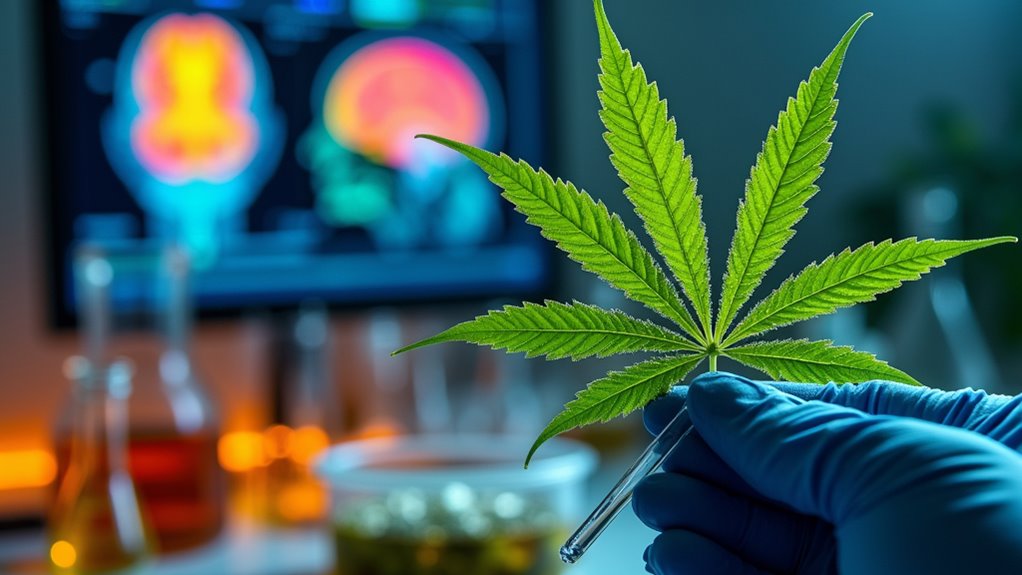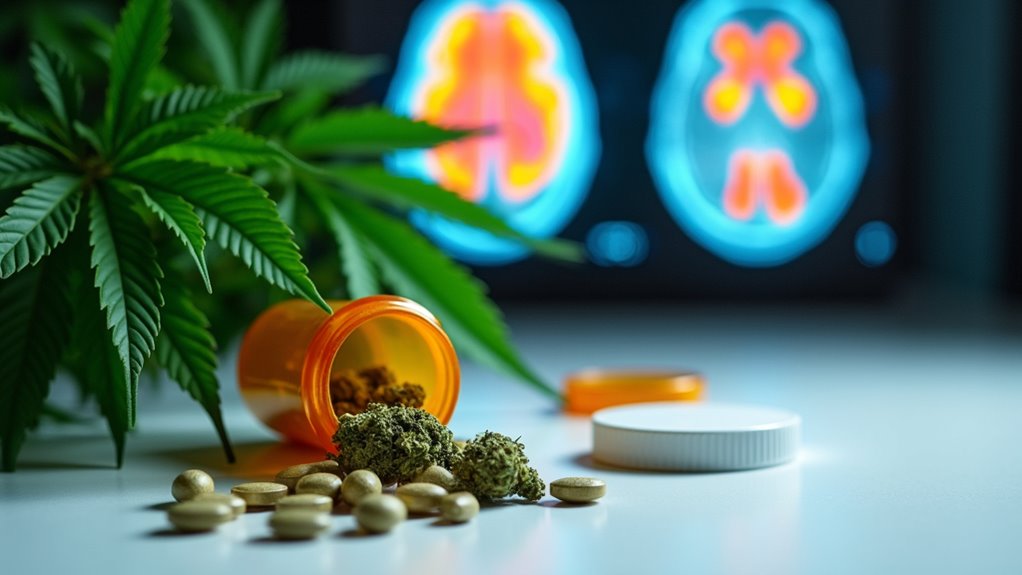Marijuana’s addictive nature stems from its direct impact on your brain’s CB1 receptors, which alter neural pathways and dopamine signaling. You’ll face a 9% risk of developing a substance use disorder, which triples if you start during adolescence. Regular use changes your brain’s structure and function, particularly in areas controlling decision-making and memory. High-potency products intensify these risks further, while genetic and environmental factors influence your susceptibility. Understanding the science reveals marijuana’s complex grip on the brain.
The Science Behind Marijuana Addiction

While many consider marijuana relatively harmless, scientific evidence reveals concerning addiction rates, with 9% of users developing substance use disorders and risks tripling for adolescent users who start early. The science behind this addiction stems from THC’s impact on your brain’s receptor binding mechanisms, particularly affecting CB1 receptors that become downregulated with chronic use.
Your genetics also play a significant role specific gene variants and family history can increase your susceptibility to cannabis dependence. What’s more concerning is that modern high-potency products intensify these risks by causing more dramatic alterations to your brain’s endocannabinoid system. Users often experience rapid heart rate and bloodshot eyes as immediate physiological responses to marijuana use.
You’re especially vulnerable during adolescence, when your brain’s prefrontal cortex is still developing. THC disrupts this pivotal development period, leading to more severe withdrawal symptomology and higher dependency risks.
Brain Changes and Neural Pathways

Scientific research reveals substantial changes in your brain’s structure and function with prolonged marijuana use. When you regularly consume cannabis, your brain undergoes significant neuroadaptations, particularly in CB1 receptor density and dopaminergic transmission disruption.
Regular cannabis use fundamentally alters brain structure through CB1 receptor changes and disrupted dopamine pathways, according to scientific findings.
Your prefrontal cortex shows reduced activation during cognitive tasks, while your anterior insula‘s ability to monitor errors becomes compromised. Research demonstrates that working memory tasks show notably decreased brain activation in heavy cannabis users.
These alterations aren’t temporary your hippocampus may retain changes even after you stop using. Studies show adolescents who use cannabis frequently develop thicker cerebral cortices. The impact becomes more pronounced with neurodevelopmental timing effects, especially if you start using during adolescence.
Your brain’s endocannabinoid system faces lasting imbalances, affecting natural reward processes and decision-making abilities. This rewiring of neural pathways explains why you might experience persistent cravings and difficulties maintaining abstinence, even when you want to quit.
Risk Factors for Cannabis Dependency

Recent studies have identified several key factors that considerably increase your risk of developing cannabis dependency. If you start using cannabis before critical age, you’re substantially more likely to develop problematic use patterns and long-term dependency. According to scientific data, 77.2 percent of users reported consuming cannabis products beyond traditional dried flower.
Your risk also rises tremendously if you have pre-existing psychiatric conditions like anxiety or depression. Family history plays a pivotal role if you have relatives with substance use disorders, you’re genetically more vulnerable to cannabis dependency.
Your socioeconomic status and patterns of polysubstance use can further complicate these risk factors. The product forms you choose matter too high-potency cannabis and concentrated extracts carry greater addiction potential.
Understanding these risk factors helps you make informed decisions about cannabis use and recognize when you might need professional support.
Clinical Evidence and Research Data
Clinical research reveals that marijuana’s effects on your brain go beyond temporary intoxication, with studies showing disrupted dopamine signaling and altered CB1 receptor sensitivity in chronic users.
You’ll find clear evidence in brain scans showing reduced activation during memory, reward processing, and emotional regulation tasks among heavy cannabis users who’ve consumed more than 1,000 lifetime doses. Cannabis use disorder affects 16.3 million Americans, making it a significant public health concern.
Recent clinical trials of AEFO117, a selective CB1 inhibitor, demonstrate promising results in reducing both THC’s psychoactive effects and users’ decisions to consume cannabis, offering potential treatment pathways for cannabis use disorder. The groundbreaking drug demonstrated a 38% reduction in cannabis-related positive mood effects compared to placebo during clinical trials.
Brain Chemistry Changes Observed
Compelling evidence from brain imaging studies reveals how marijuana fundamentally alters the brain’s chemistry through multiple pathways. Your brain’s reward circuits become dampened through decreased dopamine receptor alterations, making it harder to feel pleasure from normal activities. You’ll experience blunted responses to rewards as cannabis hijacks your natural motivation systems.
Most concerning is the impact on hippocampal maturation disruption, especially if you start using during adolescence. Your hippocampus, critical for memory and learning, shows persistent structural changes that don’t fully recover even after years of abstinence. These alterations are particularly severe in dependent users, not casual ones. The MIND program research has shown significant cognitive performance changes in long-term cannabis users. The combination of cannabis with other substances can lead to more severe and complex brain alterations.
The changes to your brain’s white matter compromise communication between regions essential for cognition, potentially derailing educational and career trajectories. Science shows these neural adaptations mirror those seen with other addictive substances.
Clinical Trial Outcomes
Through rigorous clinical trials spanning multiple treatment approaches, researchers have documented clear evidence of marijuana’s addictive potential and treatment challenges. Trial participant selection reveals that 80% of cannabis-dependent individuals are excluded from studies due to comorbidities, limiting result generalizability. Recent trials testing medications like AEFO117 and nabiximols demonstrate significant efficacy challenges. The research shows that cannabis withdrawal symptoms were not significantly different between treatment and placebo groups during the 12-week study period.
| Treatment Aspect | Key Finding |
|---|---|
| Long-term Outcomes | 9-month follow-up shows frequency linked to severity |
| Cognitive Impact | Working memory and attention deficits observed |
| Medication Response | Site-specific treatment interactions noted |
| Treatment Success | Behavioral components improve medication efficacy |
You’ll find medication efficacy varies widely, with some trials failing to meet primary endpoints despite promising early results. When accounting for dropouts through modified intention-to-treat analysis, researchers have identified complex patterns in treatment response requiring careful statistical adjustment and extended monitoring periods.
Treatment Options and Recovery
Individuals struggling with marijuana addiction have access to a diverse array of evidence-based treatment options. These include behavioral interventions like Cognitive Behavioral Therapy (CBT) and Motivational Enhancement Therapy (MET), which help you modify harmful thought patterns and address ambivalence about change. Current evidence shows that longer treatment durations lead to better outcomes in recovery. Studies indicate that withdrawal symptoms like irritability, anxiety, and sleeplessness often necessitate professional support during early recovery.
While there aren’t FDA-approved medications specifically for cannabis use disorder, promising research investigates options like N-acetylcysteine for craving management.
You’ll find that culturally competent treatment and integrated care approaches are indispensable components of recovery. Support systems, including Marijuana Anonymous and family involvement, play pivotal roles in maintaining sobriety.
Treatment plans often combine multiple strategies, recognizing that recovery isn’t one-size-fits-all. Despite challenges like high relapse rates and insurance limitations, emerging technologies and personalized interventions continue to improve treatment accessibility and effectiveness.
Long-Term Health Implications
Your brain’s structure undergoes lasting changes from chronic marijuana use, with evidence showing reduced gray matter and altered connectivity between vital regions.
While your cognitive abilities may gradually decline due to these changes, particularly in areas controlling memory, attention, and decision-making, the severity often correlates with how early you began using and how heavily you consume. Studies have shown that long-term cannabis users experience an average IQ drop of 5.5 points from childhood to midlife. Those who start using before age 18 are more likely to develop dependence and addiction issues.
Research suggests that some memory problems can improve after you quit, though complete reversal isn’t guaranteed, especially if you started using during adolescence.
Brain Structure Changes Persist
Recent neuroimaging studies reveal that chronic marijuana use causes persistent structural changes in the brain that can last for decades, even after prolonged abstinence. You’ll find the most significant neurotransmitter disruption in regions with high concentrations of CB1 receptors, particularly the hippocampus, where structural abnormalities persist well into adulthood.
Your brain’s white matter integrity also suffers, showing reduced connectivity in the corpus callosum and prefrontal cortex. The data shows altered brain connectivity also impacts crucial networks responsible for executive function and default mode processing. These changes are especially pronounced if you started using marijuana during adolescence, when your brain was still developing. Even if you quit later in life, the damage doesn’t fully reverse especially in the hippocampus, where reduced grey matter volume and altered CB1 receptor function continue to impact memory and cognitive performance. This evidence strongly supports marijuana’s potential for creating lasting neural changes.
Cognitive Function Deteriorates Gradually
These structural brain changes manifest in a progressive decline of cognitive abilities, particularly affecting how you process and retain information. Your brain’s working memory, executive function, and attention span gradually deteriorate with continued use, mimicking age-related decline but at an accelerated tempo.
Research shows that your IQ can drop considerably with regular cannabis use, regardless of socioeconomic status. A New Zealand study found that persistent cannabis users experienced an average decline of 5.5 IQ points from childhood to midlife. The severity of cognitive decline follows a dose-response pattern – the more frequently you use, the worse the impact. You’ll likely experience slower processing speeds, difficulty with complex problem-solving, and persistent memory issues. While moderate users might see some recovery with abstinence, heavy users often face lasting deficits in learning and memory functions, especially in areas with high CB1 receptor density, like the hippocampus and prefrontal cortex.
Memory Problems May Reverse
Just how permanent are marijuana’s effects on memory? The scientific community hasn’t reached a consensus on the reversibility of deficits, but research offers some insights into potential recovery strategies.
Current studies show that cannabis-induced changes in brain function can persist even after stopping use, particularly in regions critical for memory and decision-making.
Key findings about memory recovery include:
- Sleep quality improvement may help restore memory function, as better sleep supports memory consolidation
- Reduced CB1 receptor availability might recover over time after cessation of use
- Brain activation patterns can normalize in some regions, though timeline varies
- Working memory deficits may improve once THC is cleared from your system
While complete reversibility remains uncertain, addressing sleep issues and abstaining from cannabis use may support cognitive recovery.
Frequently Asked Questions
Can Marijuana Addiction Affect Fertility and Reproductive Health in Both Men and Women?
Yes, marijuana use can profoundly affect your fertility through diverse reproductive challenges. In women, you’ll experience hormone disruption affecting ovulation cycles and egg health, potentially doubling infertility risks.
For men, THC can interfere with sperm development and function through cannabinoid receptors in reproductive organs. If you’re using marijuana regularly, you’ll face diminished conception rates and may encounter difficulties with fertility treatments like IVF.
How Does Marijuana Addiction Compare to Alcohol Addiction in Terms of Recovery?
You’ll find that marijuana and alcohol addiction have distinct recovery process durations and addiction severity factors.
While alcohol withdrawal can be physically dangerous and require medical supervision, marijuana withdrawal typically presents milder physical symptoms. However, you’re likely to face psychological challenges with both.
Research shows alcohol recovery often spans 3-12 months for acute symptoms, while marijuana’s psychological dependencies can persist for several months, though typically with less severe physical manifestations.
What Role Does Secondhand Marijuana Smoke Play in Developing Addiction Patterns?
You can develop addiction patterns through secondhand smoke, particularly in unventilated spaces where passive exposure leads to measurable THC levels in your system. When you’re regularly exposed to marijuana smoke, you’ll experience minor psychoactive effects and cognitive changes that mirror active users, though at lower intensities.
While direct evidence linking secondhand exposure to addiction is limited, repeated exposure can sensitize your brain to THC’s effects, potentially increasing vulnerability to dependence.
Can Religious or Spiritual Practices Help Overcome Marijuana Addiction More Effectively?
Research shows that spiritual practices, especially when combined with psychological counseling, can boost your recovery from marijuana addiction. You’ll likely benefit most from an integrated approach that includes contemplative meditation alongside evidence-based treatments.
While spiritual interventions alone aren’t necessarily more effective than other therapies, they can provide valuable coping strategies and community support. The key is finding a personalized approach that aligns with your existing beliefs and values.
Does Marijuana Addiction Affect Different Ethnic or Cultural Groups at Varying Rates?
Yes, you’ll find significant variations in marijuana addiction rates across ethnic and cultural groups. Native Hawaiian/Pacific Islanders and multiple-race individuals show the highest usage rates, while Asian adults consistently report the lowest.
These differences stem from complex social determinants, including access to healthcare, economic factors, and cultural norms. While genetic predisposition may play a role, environmental factors and policy differences heavily influence how marijuana addiction impacts different communities.







